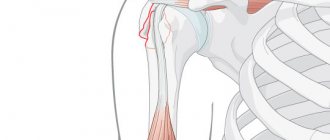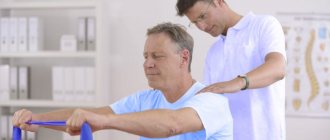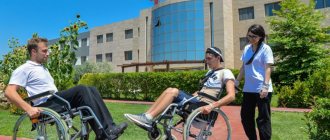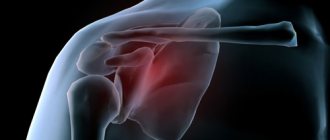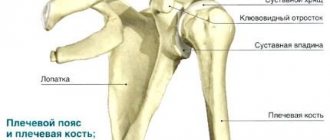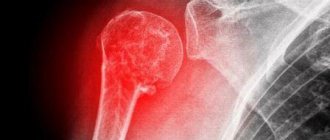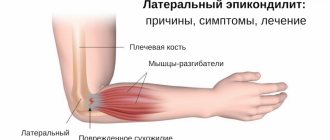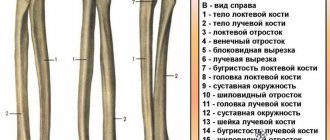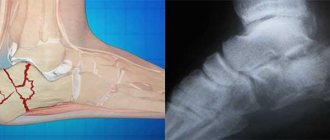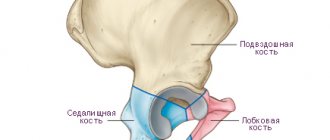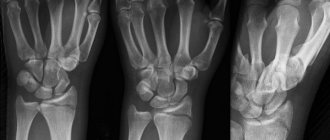Osteosynthesis for a humeral neck fracture
A crack or break in the upper part of the humerus is called a humeral neck fracture .
The main patients are women and elderly people. The cause of injury is a fall in which the arm is pressed against the body or pulled back. A fracture is manifested by pain, swelling, and limited movement of the injured limb. In some cases, a bone crunch can be heard. The diagnosis is confirmed by X-ray examination. Standard treatment is anesthesia, reposition, and immobilization. If reposition is difficult, surgical intervention is required. The humerus is very vulnerable; its damage accounts for about 13% of all injuries with fractures. In terms of frequency, it occurs in slightly less than 100 cases per 100 thousand population per year. Young people receive similar injuries as a result of accidents, falls from heights, and impacts. Elderly patients can break a bone if they fall from their own height. This difference is explained by the development of senile osteoporosis, when bones become fragile and brittle. In this condition, the patient only needs to fall on his elbow or hand to get a fracture.
Displaced fracture of the humerus. Osteosynthesis with a titanium plate. Part 1
I never thought I'd break anything. And even more so, I could not imagine that fractures received at home could require surgical treatment. However, there is a first time for everything.
If you found this article, you have probably also experienced a fracture or are about to undergo surgery. I found practically no useful information before the operation, although I intensively scoured the Internet. I sincerely hope that this article will help someone find answers to their questions, will calm someone down and will not be so scary.
How I broke my arm
A slippery country porch after the rain, my hands full of things - I couldn’t hold on to the railing. A split second - and I was already sitting on the steps. It hurts somewhere in the hip area. I try to get up, but I understand that my left hand does not obey me. I hear some kind of grinding sound inside (the edges of a broken bone are rubbing against each other). There is no pain in my arm, it's because I'm in shock. Almost lost consciousness. When they lifted me up and sat me down on a chair, I noticed that I was intuitively supporting my sore arm with my healthy one. The hope of a dislocated joint quickly disappeared when I tried to move my left arm and bend it - it hung like a whip, and fragments were moving around inside, unnaturally inflating the arm from one side to the other. This sight made me feel sick, my head was spinning, and my legs were weak.
As I realized later, I fell on my hip, but during my inglorious flight my arms went to the sides, and one of them hit the railing with all its strength, which is why it broke.
An hour later I was at the emergency room in Solnechnogorsk. On a first-come, first-served basis, they took pictures and put me in a plaster cast. The pictures showed a helical fracture of the humerus in the lower third (closer to the elbow) with displacement. The local traumatologist immediately told me that surgery would be required and asked which hospital to refer me to. Thus, that same evening I was taken to the hospital at my place of residence, where at 11 pm I was hospitalized, and I fell asleep almost exhausted on the newly acquired bed 36 of the Moscow hospital.
picture immediately after the fracture (without plaster)
First hospital
I got to the hospital on Saturday night, and, of course, no one began to urgently attend to me, they just took new pictures. On Sunday they took tests and injected me with analgin a couple of times. I couldn’t understand where my doctor was, whether there would be an operation and when, how long I would be stuck in this institution where I was supposedly being treated. When they came to do an ECG, I was almost sure that this was a sure sign of preparation for the operation. But everything turned out differently: my attending physician came in the afternoon and doubted the advisability of the operation. He said that he would discuss this situation with the head of the department and get back to me. The manager came in a little later and was also full of doubts. According to him, “the bone in the cast stood up straight and will heal on its own,” so surgery is not necessary in my case. However, the doctors themselves could not make such a decision; they began to wait for the professor. The professor called a consultation and all these people came to my room. They examined me, checked whether my fingers were working and informed me that they would not operate, saying I was lucky and it should heal that way. And the next day I was discharged home. So I spent 4 days in the hospital without any treatment.
It is clear that nothing is clear
Then I was recommended to be observed at the emergency room at my place of residence. The first time I came there without photographs, only with an epicrisis. When the time came to redo the X-ray, 2 weeks had already passed since the fracture, and the traumatologist, seeing the new X-ray, said that I needed surgery and would do it quickly. I was at a loss: some traumatologist against the opinion of the whole council? However, the latest photo seemed scary to me too.
picture 10 days after the fracture in a cast
A couple more days passed, out of fear, I redid the picture again, but in a different projection, and what I saw there scared me wildly. Because SUCH a bone will definitely not heal.
It was clear that the bone was not standing as it was before; the fragments were moving despite the plaster splint. And I began to collect the opinions of other doctors. They all said one thing: an operation is needed, don’t delay, the longer the time passes, the harder it will be for the surgeon.
I had to take all the tests again, take an X-ray of my lungs and an ECG. At that time, I already knew that I would go to have an operation at hospital No. 83. Through friends and acquaintances I was recommended to see Dr. Gorelov. During the consultation, he seemed reasonable and even somewhat pessimistic to me (in fact, he just honestly warned about the risks), but a qualified doctor. I couldn't find any reason not to trust him. I liked the inpatient facility in the hospital - two and single clean rooms with TV, Wi-Fi and even air conditioning. In general, I was satisfied with everything.
I was operated on on September 14, and 2 days after the operation I was discharged, making me promise to come for dressings. In general, I liked all the staff in this hospital - the doctors, my anesthesiologist and attentive nurses. I want to express my gratitude to everyone for their professionalism and help.
I.V. Gorelov is a very kind, competent, calm and patient doctor, answers all questions in detail, calms and encourages. No familiarity or attempts to tease the patient, make a bad joke, etc. Such qualities of a doctor are very important to me, because you listen to every word and, to some extent, the doctor is an authority for the patient, whom you need to completely trust and follow all instructions. And if the person himself or communication with him is unpleasant to you, then this complicates everything and there is no trace of any positive attitude.
Displaced humerus fracture and treatment options
Doctors say that it is not so easy to break the humerus - it is one of the largest and strongest human bones. Displaced fractures are extremely rarely treated conservatively. This also takes a rather long time for the bone to heal and there is a high probability that after a couple of months in plaster the bone will heal crookedly. But the most unpleasant thing is that it may not heal at all, and a false joint may form at the site of the fracture, which is very, very bad.
Surgery can be risky because the radial nerve runs along the humerus to the elbow. In simple terms, this nerve is responsible for the functioning of the hand. If it is damaged during surgery, the hand may simply “hang” for a long time. But doctors do not give guarantees, each person is individual, some may be unlucky.
The operation itself involves the installation of a titanium periosteal plate, which is secured to the bone with screws screwed into the bone. The difficulty is that the radial nerve runs straight through the bone, so in order to get to it, you need to isolate the nerve and place “shock-absorbing” muscle tissue under it (between it and the plate). This operation is not considered simple; personally, it took me about 2.5 hours to do it. What a relief it was to see that the fingers were moving, that the nerve was not damaged. After the operation, the doctor said that the muscle began to wrap around a fragment of bone, which made it impossible for it to heal. Therefore, the decision to undergo surgery was correct.
In my case (the operation was complicated by the age of the fracture), general anesthesia with a mask and tube was suggested. And fresh fractures of this type can be operated on under local anesthesia (anesthesia in the neck, which cuts off the sensitivity of the arm). Personally, I think that general anesthesia is better because you don’t see your blood and don’t hear your bones being drilled. Not every person can handle this. And I liked mask anesthesia much more than intravenous anesthesia (I had such experience) - it was easier to recover from.
Preparation for osteosynthesis with a titanium plate and the first days after it
Discuss treatment options with your surgeon. If the fracture occurred recently and the bone did not break at the joint itself, you may be offered to install a pin - a metal rod that is driven into the bone, which will fix it from the inside. Less risk to the radial nerve and small scars on the arm. Installing the plate means a big scar, preceded by a big seam (I’m already slowly thinking about a tattoo). In my case it was too late and difficult to use the pin, so we agreed on a plate.
The patient purchases this accessory himself, through a doctor, or looks for it on his own. My German plate cost 103 thousand rubles. No matter how you buy the plate, ask for receipts and documents for it. We bought from the supplier company. No one showed us the plate itself, arguing that it would be delivered directly to the doctor, and it is not recommended for mere mortals to touch this sterile device. But a bunch of certificates were handed out. Yes, the price was high, and it depends on the length of the plate. Mine covers almost the entire humerus. Someone may be luckier and find it cheaper.
Before the operation, you must undergo a standard medical examination. examination by a therapist, have a fresh fluorography on hand, as well as an ECG, blood and urine tests. With this heap of papers you come to the hospital, and the longest day of your life begins. After lunch they will no longer feed you, and in the evening they will completely cleanse your intestines and prohibit you from drinking after midnight. In the morning, on an empty stomach, you will be stripped naked, given an antibiotic injection into a vein, and taken to the operating room.
I was taken to surgery straight away with a cast on my arm. I have no idea how they filmed it - it was already under anesthesia. In the operating room, a catheter is placed in the arm and a mask is applied. I passed out after 15 seconds to the music of the band Spleen, sounding relaxed in the cold operating room.
When I woke up, I saw people in dressing gowns, they calmly talked to me, they said that I had only lost half a liter of blood, which was not much. Then they took me to the ward. A stonehenge of ice in bags was laid out around the operated arm, taped with a bandage, and an IV was connected to the healthy arm. At this point the worst was over.
For the first 2 days, blood leaked from the stitches, so I had to put special diapers on the bed. This is absolutely normal, although it looks creepy. Also, after surgery, elevated temperature (up to 37.5 within a week) and severe swelling of the arm are normal. My hand has become 2 times larger, the sight is unsightly and scary. However, this is normal given the damage to the muscles and tissues of the arm - the blood supply needs time to recover, and this is not a couple of days.
While the stitches are bleeding, dressings are done daily, then as directed by the doctor. It is better not to disturb dry seams again. They are removed on the 12th day after surgery.
You should try to bend the operated arm (slowly develop it), massage the hand to remove swelling and wear the arm in such a position that the hand is higher than the elbow - this will reduce swelling. In my sleep, I put my hand on my stomach - in the morning the swelling is much less than in the evenings.
Upon discharge, I was prescribed a course of antibiotics and painkillers (if necessary).
All the bandages-scarves-splints from pharmacies seemed uncomfortable to me, they put pressure on the seams, so I wear my arm loosely, slightly bending it at the elbow. It's not difficult, don't be afraid to not support it. For the first 2 days I tied my arm with a Pavloposad scarf, but now I’m just walking (a week after the operation) without holding it in any way. I use my hand minimally - open the lid, take the mug. There is almost no strength in the arm yet, but it will return with the development and restoration of the injured muscles.
With this I want to finish the first part of my story. The next post will be devoted to the rehabilitation and development of arm muscles.
If you have questions, be sure to ask in the comments. I know from myself that in such a difficult situation you cling to every review, collect information literally bit by bit, and this ignorance is frightening and disorienting.
Health to all our readers!
Osteosynthesis of the humeral neck
The operation to treat humeral fractures using plates, pins, and external devices is called osteosynthesis of the humerus . It is intended for the restoration of a broken bone. Prescribed for the formation of fragments or displacement of fragments. The purpose of the operation is to restore the bone structure and fix the fragments until complete fusion.
Osteosynthesis , which restores the shoulder in case of intra-articular fractures of the head and neck of the humerus, when there is a shift and separation of the proximal part, is performed using the open fixation method. It is recommended to perform the procedure with normal blood supply and intact integrity of the cartilaginous segment. When the head is crushed and its nutrition is disrupted, the possibility of necrotic changes remains possible. Joint destruction suggests a choice in favor of endoprosthetics.
The choice of method of shoulder osteosynthesis with plates depends on the diagnosis and condition of the patient. You can choose the extramedullary method using plates for osteosynthesis of the humeral neck or the intramedullary method when wires are used. Both methods are internal, that is, submersible. The fragments are fixed with screws, knitting needles, pins, plates, and wire.
External (percutaneous) options include the use of devices that fix the bone from the outside.
Proximal humerus. Minimally invasive plate osteosynthesis (Part 1)
Fractures of the proximal humerus
In most cases, these are fractures in elderly patients, due to osteoporosis, with an incidence of about 5%. This type of fracture occurs three times more often in women than in men.
When treating this type of fracture, among other things, the nature of the fracture, the presence of displacement of fragments, and the integrity of the rotator cuff must be taken into account, since all this affects the outcome of treatment. Malunion means pain, loss of function of the joint and the limb as a whole. During surgery, one of the serious problems can be the low quality of bone tissue, and, as a consequence, the stability of the “bone-fixator” system.
Let's look at the possible surgical treatment options.
Closed reduction and percutaneous fixation with Kirschner wires.
Even with successful reduction and satisfactory fixation, this method does not allow early functional treatment. Prolonged immobilization will lead to joint contracture, primarily caused by the fracture. The chances of a good functional result in this case are low.
Osteosynthesis
With open reduction, the surgeon has the opportunity to revise the rotator cuff and the work on comparing and fixing fragments becomes more effective. Depending on the chosen implant, be it a plate or an intramedullary nail, the surgical approach changes. An important condition is to take maximum care of soft tissues and minimize damage associated with surgical intervention. This means that when choosing an implant, it is necessary to take into account how it interacts with the cortical and spongy bone, the periosteum, and the soft tissues covering it.
Endoprosthetics
Often, the severity of the fracture determines endoprosthetics as the only possible treatment option. As a rule, these are elderly patients, with bone quality insufficient for fusion. However, indications for shoulder arthroplasty have changed over time due to advances in technology in the surgical treatment of fractures. Surgical techniques are improving, and it has become possible to fix three- and four-part fractures. Modern instruments make it possible to minimize access; modern implants make it possible to achieve interfragmental compression where previously it was impossible.
When an implant that meets all modern requirements allows you to combine different techniques and the necessary innovations, it becomes the solution for the treatment of complex fractures, allowing you to avoid endoprosthetics, increasing the chances of saving the joint.
Osteosynthesis system with polyaxial locking screws
NCB-PH allows for minimally invasive osteosynthesis with a plate without pressure on the periosteum, with the possibility of using cannulated locked cancellous screws to enhance the reliability of fixation in the cancellous bone.
To be continued
To learn more
NCB, NCB-PH, osteosynthesis, shoulder fracture, shoulder, proximal shoulder, trauma, shoulder arthroplasty
Time and place of surgery
The operation is performed in a hospital under general anesthesia. The shoulder is operated on if treatment with traction or plaster is not possible. When performing surgery, the fragments are fixed with screws and plates for a fracture of the humeral neck .
The most fragile part of the shoulder (the part of the arm located above the elbow) is the surgical neck, the part located in front of the shoulder joint. It can easily be damaged if it falls, gets pinched by a door, or hits something hard. A fracture can occur in one of three areas of the humerus:
- upper;
- lower;
- in the body of the humerus.
The decision on the advisability of the operation and the need to install a reconstruction plate is made by a traumatologist. He may consult with the patient's family, especially if the operation is required for an elderly person.
Features of osteosynthesis of the humerus
Fixation of the humerus can be external or internal. For temporary use, the best option is an external device. It is quickly installed and adjusted if necessary. Does not require a special room for installation.
Indications for the use of external fixation devices:
- in the presence of serious injuries, multiple injuries to the bones of the extremities;
- for severe injuries of the humerus complicated by extensive soft tissue damage.
For other cases, it is better to use internal fixing devices. It is better to use nails to fix acute and pathological fractures.
If the fracture is characterized by multiple fragments, a metal plate is used to align them in a fracture of the humeral neck. A noticeable displacement of the proximal part indicates the need to achieve the most accurate anatomical reduction. This is especially important for older patients, who have a significantly higher risk of bone failure. To avoid loss of limb functionality, the plate after a humeral neck fracture must be of the required length and provide sufficient fixation points in the proximal humerus (humeral head).
For fractures that are characterized by compression of bone fragments, it is necessary to install a shoulder plate with compression lining.
Depending on the origin of the fracture, it may be necessary to achieve stable anchorage with tension screws reinforced with a neutralizing plate. An alternative option is to avoid intervention in the fractured area and install a bridge plate.
Rehabilitation after osteosynthesis of the humerus. Scar and care for it. Exercise therapy. Should I pull out the plate?
Almost 5 months have passed since osteosynthesis on the humerus. In this article I will tell you how to develop a hand after a fracture and what results you should expect.
already talked about the first days after surgery , but I will repeat it again - the first week after you are a real wreck with a swollen hand. I didn't have the strength to do anything, let alone work out before the stitches were removed. I was wildly afraid that they would burst and blood would flow, so for the first 12 days after the operation I did minimally doing anything with my hand. After the stitches were removed, things went faster. However, doctors give very strange recommendations on how to develop an arm. Basically they say “develop!” And what, how and how much - you have to pull out of them with pincers.
After my fever subsided (and it lasted for almost 2 weeks), and my palm and fingers stopped swelling so much, I started working at the computer and did very simple gymnastics during breaks. I tried to reach my face with my almost stiff hand. At least with one finger. This did not happen on the first day. You sit and stretch your muscles, trying to reach your forehead with your thumb (back and forth, back and forth). I could sit like this for about 10 minutes, on the best days it hurt my forehead, on days when it was painful I gave myself some indulgences. Doctors will tell you to exercise your arm through the pain. Personally, I am not a supporter of this approach. A couple of weeks after surgery is not the time when you need to show off until your eyes sparkle. You still can’t warm up properly, walk or squat, so active gymnastics without warming up gives you unpleasant sensations. Wait, everything has its time, you won’t be left with your arm bent forever, believe me.
At first, I was not so much bothered by the inflexible joint as by the redness of the stitches, the pain in them and the hot skin around them. It seemed to me that this was some kind of inflammatory process that needed to be removed. I turned to the surgeon Kostritsa at the Soyuz clinic (Moscow), who advised me to use 2 ointments alternately for a month: Dolobene gel and Lyoton. In addition, I already actively smeared the seam with Contractubex (I still use it to this day) . With the ointments I felt much better, the tissues no longer hurt as much. But there was still pain and a feeling that the whole arm was one big bruise. Then I decided to go to physical therapy. True, I thought of this already when I went to work. And this happened only 1.5 months after the operation.
PHYSIOTHERAPY AFTER OSTEOSYNTHESIS
Since you have a plate or pin in your hand, you will not be prescribed any physical therapy other than laser. The procedure is absolutely painless, you just lie down on the couch, cover the seam with boxes that emit red light, and lie there for 10-15 minutes. The laser resolves compactions, helps speed up cell regeneration, and most importantly, it prevents the formation of keloid (dense and bulging) scars. In my case, it was already too late - the scar had become convex in places. But I’m still glad that I looked like a laser. Do not neglect this procedure, it will significantly speed up tissue restoration. I did it for a fee - 300 rubles per session or so.
Another point is that, as always, I had some incidents. The physiotherapist began to advise me of a massage therapist she knew. This despite the fact that it was painful to touch my hand. What kind of massage? To this she had an answer: “you need a massage of the cervical-collar area to relieve general tension.” I scratched and scratched my turnip and decided that this was complete nonsense. The second joke was made by a nurse in the same treatment room. After the procedure, she intercepted me in the corridor and thrust some kind of note with a code (?) and store addresses into my hands. In a whisper she began to advise me on some medications that I could only buy there and said that I desperately needed them. In general, under the guise of concern, she tried to recruit me into some network company selling strange drugs. These women and their intrusive advice left a disgusting impression. Be prudent, not every procedure and drug you really need.
Exercise therapy AFTER OSTEOSYNTHESIS
I was always very skeptical about exercise therapy, because it seemed to me like an activity for grannies who have osteochondrosis or something like that. However, I was wrong. Exercise therapy can be very useful in the case of rehabilitation after fractures. When all the surgeons vaguely advise something like “well, do this and do this and that,” the exercise therapy doctor will devote a whole hour to you, during which you will go through a bunch of exercises, and you will definitely remember half of them. Contact a good doctor in Moscow here . I personally don’t see the point in constantly going to exercise therapy classes - you go a couple of times, remember the bulk of the exercises and that’s it - you do it at home, when it’s convenient for you. The main task is to restore mobility to the elbow joint. This is very difficult, considering that he loses flexibility incredibly quickly. Since I was in a cast for 3 weeks, and then still didn’t move my arm much after the operation, my case can be considered quite advanced. I can’t imagine how those who walked in a cast for 1.5-2 months restore their hands.
HOME GYMNASTICS
If suddenly you are unable to get an appointment with a physical therapy doctor, I will tell you how I restored my arm. But keep in mind that these are not recommendations. And I'm not a doctor. This is just my experience.
Charging at the first stage is simple and short.
First you need to warm up. The blood must supply the hand well. To do this, you can do squats/walk quickly for 5-10 minutes. It should get hot. Next comes the exercises. Each exercise is done 10 times, then you need to shake your hand and rest for a few seconds. Then do another 10 repetitions and shake again. And the third time. That is, you will perform each exercise 30 times (3 sets of 10 repetitions). This may be difficult at first, so do as much as you can.
So, we have warmed up thoroughly, then we need to warm up the shoulder joint and hand - healthy joints. Circular rotational movements of the hand in different directions, and rotational movements of the shoulder (back and forth, down and up).
After this, extend your arm in front of you and try to make rotational movements only with the elbow joint. Not with your shoulder or hand.
And now my 2 main exercises , which very well help straighten a bent arm.
1) Done while standing. The sore arm is straightened. With my healthy hand I support the elbow of the sore arm from below. There is a small weight in the affected hand (0.5-1 kg). The hand of the affected hand is suspended, so the hand begins to involuntarily unbend under the weight. You can stand like this for a long time. This exercise does not need to be done 10 times :). It is enough to stand like this for 5 minutes, then you can do 10. At first, do without weight, then take increasingly heavier weight. I think 1.5 kg maximum. Do not need anymore. You can also do it while sitting, for example, by placing your sore hand on the edge of the table on some kind of pad.
2) The second exercise is extension and flexion of the arm with resistance. Also while standing, bend and straighten your arm at the elbow (palm facing you), only this time when bending you should interfere with yourself with your healthy arm, lightly pressing on the sore one in the wrist area at the time of bending. This way you increase the load on your arm and make it harder to bend. I do this exercise 10 x 3.
I have not done anything through pain and am not a supporter of this approach. I'm not my own enemy. Therefore, if pain occurs, stop.
After this exercise becomes simple for you, you can begin to perform more complex complexes. Like this. On this channel you will find 3 videos that show exercise therapy classes very well and clearly. Everything is done at home.
If your arm has almost straightened and is not much different from a healthy one, start working out with dumbbells. Do all the basic exercises for biceps, triceps and shoulders. These are all kinds of dumbbell flyes, raises, overhead and overhead presses, etc. All these complexes can be easily searched on Google.
The main thing is to do it.
SHOULD I REMOVE THE PLATE OR NOT?
I don't want to do this for a number of reasons. First of all, my surgeon said that I could live like this. He staged it, he saw everything. He takes responsibility for these words. All the other surgeons say it would be nice to pull it out. Yes, I understand that this is a paid operation that the state and insurance will not pay for. Is this why all surgeons advocate its removal so much? What are the arguments? I haven't heard anything convincing. All doctors only say that it is advisable to do this. And what kind of terrible consequences could there be, given that titanium does not oxidize and does not come into contact with the body at all - I don’t know.
Secondly, I have a big, ugly scar. I don't want to torture my hand anymore and have it cut again. In addition, this is another general anesthesia, which I do not tolerate very well.
Thirdly, I want to cover the scar with a tattoo. The faster the scar becomes painless, the faster I can do this.
Yes, I understand that the plate will slightly restrict the movement of the arm. Just a centimeter or less. But this inconvenience is imperceptible, and another general anesthesia, hospital leave and stitches are very much so. In general, everyone decides for themselves; even doctors don’t have a clear opinion.
AFTER 5 MONTHS FROM THE DAY OF OPERATION
- The joint is still not fully extended.
- The scar may hurt when pressed and become red and hard. In some places it looks better, in others it looks worse.
- In the morning there is still stiffness in the joint, I cannot make sudden movements.
- The joint still hurts when I lean on my elbow, I can’t carry heavy bags, my arm is much weaker than my right one. even visually there are less muscles on it.
- The hand looks like this 5 months after surgery.
 No, this is not cellulite. It ’s just that the tightness of the tissues from the seams still persists, which is why there are such “cute” bumps on the arm.
No, this is not cellulite. It ’s just that the tightness of the tissues from the seams still persists, which is why there are such “cute” bumps on the arm.
I hope that my experience will help someone survive such an unpleasant situation as a fracture. If surgery is indicated for you, do it, don’t be afraid. The human body is an amazing thing; everything can be restored, changed and improved with a little effort.
Health to all our readers!
Removing pins
The pins are removed from the humerus after 8–9 months. The removal time is determined by the doctor based on radiographic studies. It is not recommended to skip this period, because osteosynthesis devices of the humerus may become overgrown with bone tissue. Leaving the structure inside is fraught with complications. A pin removed in time will not cause any trouble, leaving no scars or holes in the bone. Removing the pin after the recommended period may result in a serious operation.
Modern materials for osteosynthesis are biodegradable. They do not need to be removed; they dissolve inside the bone.
